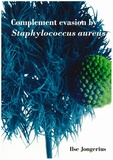Convertase evasion by Staphylococcus aures

Jongerius, Ilse
- Promoter:
- Prof.dr. J.A.G. (Jos) van Strijp
- Co-promoter:
- Dr. S.H.M. (Suzan) Rooijakkers
- Research group:
- Rooijakkers , Strijp
- Date:
- May 11, 2010
- Time:
- 14:30 h
Summary
Staphylococcus aureus secretes a large number of immune modulating proteins to resist the human immune response. A vast majority of these evasion molecules are involved in complement inhibition. In this thesis I explored the complement inhibitory strategies of three small secreted proteins of S. aureus: Staphylococcal Complement Inhibitor (SCIN), Extracellular fibrinogen binding protein (Efb) and Extracellular complement binding protein (Ecb). Although SCIN has similar structural features as Efb and Ecb, the complement-inhibitory mechanism of SCIN turned out to be completely different from Efb and Ecb. The fact that Efb and Ecb are not human specific (in contrast to SCIN) enabled us to proof the importance of these small complement inhibitory proteins in S. aureus pathogenesis in vivo.
The complement system is the first line of defense against invading microorganisms. Activation of the complement system results in the coverage of bacteria with C3b, resulting in phagocytosis, and formation of C5a which is important for chemotaxis of neutrophils towards the site of infection. In this thesis I describe that SCIN, Efb and Ecb are effective complement inhibitors. Recently, it was shown that SCIN stabilizes all C3 convertases thereby preventing C3b deposition, phagocytosis and C5a generation. In addition it was shown that SCIN is able to form dimers of the alternative pathway C3 convertase. However, the downside of stabilizing C3bBb on bacterial surfaces seems that C3b molecules within complexes could still trigger phagocytosis. I discovered that C3b molecules inside dimeric convertases are not recognized by several complement receptors since the binding sites for these receptors are blocked. We showed that dimerization of convertases by SCIN is crucial to inhibit phagocytosis.
Furthermore, I discovered that Efb and its homologue Ecb effectively bind C3d and prevent C5a generation completely. Efb and Ecb turned out to be active across all species and we were able to show that recombinant Ecb completely prevents C5a dependent neutrophil migration in mice. Furthermore, the mechanism of convertase inhibition by Ecb was unravelled. It turned out that the C3d binding part of Ecb is essential for inhibition of C5 convertases. Next, Ecb stabilizes the pro-convertase (C3bB) as a result of which active convertases (C3bBb) cannot be formed. Since Efb and Ecb are not human specific we were able to show the relevance of expressing small immune evasion molecules by S. aureus. We used a targeted mutagenesis approach to construct a S. aureus Efb and Ecb knockout strain (NewmanΔEfbΔEcb). Two mice models were used to show that Efb and Ecb are of high importance for the pathogenesis of S. aureus. In an intravenous infection model, we showed that the mortality rate of mice infected with wild type Newman is much higher compared to mice infected with NewmanΔEfbΔEcb. In addition, the amount of recovered bacteria and abscess formation is much higher in mice treated with wild type bacteria. In a pneumonia model we were able to show that mice inoculated with wild type bacteria have more bacteria in their lungs compared to mice inoculated with NewmanΔEfbΔEcb after 24 hours. Subsequently, we were able to show that this is a result of reduced neutrophil influx in the presence of Efb and Ecb.
Conclusion
The human immune system uses a diverse array of molecules to sense invading microorganisms. Here, I showed that the mechanism of action for different staphylococcal proteins that tackle the immune system can be equally redundant. The insights into the molecular mechanism of immune evasion, provides better understanding of the function of the different elements of our own immune system. Furthermore, these mechanisms can be crucial in the development of new anti-inflammatory drugs or vaccines against S. aureus. In this thesis I was able to show the relevance of expression of immune evasion molecules for the pathogenesis of S. aureus.